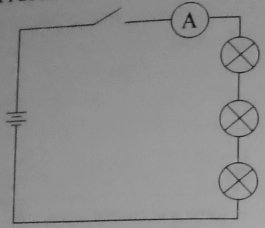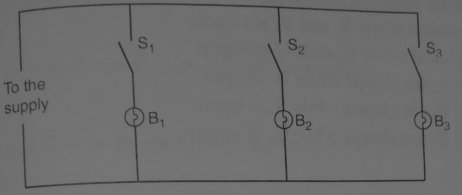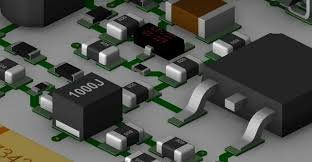Arrangement of components in a circuit can be done in parallel or in series.
The setup below shows bulbs connected in series.

When bulbs are connected in series, the electrical circuit is arranged so that the current flows through each bulb one after another, following a single path.
The bulbs connected in series gives out light of the same brightness and when one is disconnected, the others goes off. This is because same current flows through devices connected in series. When one of the devices is disconnected, it introduces an open circuit. Electrical devices connected in series offers greater opposition to the flow of current.
In series arrangement, Each component takes the voltage from the battery according to it’s ability in opposing flow of current.
parallel Arrangement of components in a circuit
The figure below shows bulbs connected in parallel.

In parallel arrangement, the bulb share the same voltage provided by the battery. Each bulb have the same voltage as the battery.
In parallel circuit, the three bulbs gives out light of the same brightness which is more brighter than that of bulbs in series arrangement. When some of the bulbs are disconnected, the rest continue lighting with the same brightness.
For devices connected in parallel, the current flowing in one does not affect the current flowing in the other devices. If one of the devices causes an open circuit, current will still flow in the other devices.
Connection of bulbs in parallel is a useful concept in domestic wiring in a connection which is refereed to as the lighting circuit. The figure below shows an illustration of lighting circuit in domestic wiring.

From the circuit shown above, each bulb can be switched on independently. One bulb blowing off will not break the circuit and so others will continue lighting.
Example problem on arrangement of components
Four cells have an e.m.f of 2.0 V each. What is the total e.m.f when the cells are in parallel and when in series?
solution
When cells are in parallel, the total e.m.f from all of them is equivalent to the e.m.f of one of the cell. Therefore, the total effective e.m.f of the cells in combination is 2.0 V
When in series, the effective e.m.f of the cells is the sum of the e.m.f of individual cell. hence the effective e.m.f will be given by:
Total effective e.m.f in series = 2.0 V + 2.0 V + 2.0 V + 2.0 V = 8.0 V
Example problem
A form one student connected three identical bulbes as shown.

Explain what happens in each of the listed case, indicating the path of current in each case:
(i) S1 is closed while s2 and s3 are open.
(ii) s2 is closed while S1 and s3 are open
(iii) S1 and s2 are closed while s3 is open.
(iv)S1 and s3 are closed while S1 is open.
(v) s2 and s3 are closed while S1 is open.
solution
(i) Bulb B2 lights because it is in a closed circuit. B1 and B3 do not light because they are in open circuits. The current will follow the path: O –> P –> R –>S –> U
( ii) Bulbs B1 and B2 lights because they are in a closed circuit . They light less brightly because of their series arrangement. path of the current is :
O–> P –>R –>S–>T –> U
(iii) Bulbs B2 lights brightly. B1 does not light since it is short circuited. B3 is in an open circuit: The path followed by the current is:
0 –> P –> R –> S –> U
(iv) B1 does not light because it is in an open circuit. B2 and B3 are in closed parallel circuit and hence they light with same brightness. There are two paths for the current which are:
O –> P –> R –> S –> U and
O –> P –> Q –> R –> S–> U
Note: Current through B2 is the same as current through B3
(v)The three bulbs lights. B1 is brighter than B2 and B3. B2 and B3 shares the current flowing through B1.
The current follows the paths: O –> P –> R –> S –>T –>U
and O –> P –> Q –> R –>S –> T –>U
Related Topics
- Communication Skills
- Arrangement of cells: Easy introduction
- Electromotive force and potential difference: introduction
- Some Trigonometric Ratios


Leave a Reply